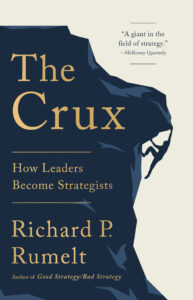Pinpointing the Crux
As someone who loves studying and implementing strategy, I read numerous books on the subject each and every year. Many offer the same tired ideas, but a few stand out and offer ideas you can use immediately.
One of those books is Richard Rumelt’s The Crux: How Leaders Become Strategists.
As it turns out, what passes for strategy in many businesses, government agencies, and military operations is ultimately just a mix of wishful thinking and a jumble of incoherent policies. In The Crux: How Leaders Become Strategists, UCLA professor emeritus Richard P. Rumelt argues that leaders become effective strategists when they focus on challenges rather than goals, pinpointing the “crux” of their pivotal challenge—the aspect that is both surmountable and promises the greatest progress—and taking decisive, coherent action to overcome it. I had the chance to connect with Professor Rumelt recently to discuss his paradigm-busting theory about strategy and how companies big and small can identify and surmount their biggest challenges.
What is the crux?
The crux is the most important challenge you face that has a good chance of being solved or surmounted in the fairly near term. It is the challenge deserving of your focused effort.
Why is it that it is so often missed, ignored, or never thought about?
The idea of the crux combines the need for focus with the concept of challenge-based strategy. Many executives fail to focus efforts, diffusing their activities and resources. This is the natural outcome of trying to please and satisfy many different voices and interests. In addition, there is a common habit of thinking about strategy in terms of goals—desired end states. But, these are ambitions, not actions. Strategy is about devising actions that will surmount a challenge.
What do many corporate leaders get wrong when it comes to strategy?
The major error is building strategy around goals, particularly desired financial outcomes. Yes, we want to “win the game,” but saying so is not a strategy. To develop a strategy, one has to look at the competition and our team and figure out the difficulties and barriers to “winning the game.” Only then can you devise an action plan for moving forward.
This corporate displacement of strategy with goals has increased over the last decade or two. It seems to come from the incentive packages created for leaders and the plethora of writings urging leaders to clarify their goals. If the only problem was motivation, this would work well, but when facing actual challenges, it is grossly insufficient.
How should a leader start to identify the crux of the organization and form a long-term strategy?
There is no substitute for insight in defining a crux and seeing a way through it. Insight is stimulated by looking at the challenge—by working to discover the central paradox that makes it a problem. We ask questions like, “What makes this so hard?” and “How have others coped with similar problems?” and “What constraint are we imposing that can be removed?”
It is also important to understand that the crux is not the most gigantic challenge you face—there is no point in trying to do the impossible. The crux is the biggest challenge you have a good chance of solving.
I don’t have much time for the concept of “long-term strategy” unless you are running a utility company or one that requires enormous capital investments. For most organizations, strategy is a journey through one challenge after another. At each stage, there is the need for strategizing. If you take some sort of “long-term” strategy for granted, then it dulls the sensitivity to necessary changes and new entrepreneurial moves.
You share many stories in the book from SpaceX to Netflix to Salesforce.com. Would you highlight just one for our audience that illustrates your principles?
 Marvel is a nice example. In 1999 Marvel had just come out of bankruptcy with a comic-book and toy business and with a huge debt burden. The company had an avid following among comic-book readers, but no general audience. Much of the debt was paid off by licensing out characters just for toys and games. The big opportunity lay in making Marvel characters into feature films. One problem was classic chicken-and-egg: Studio licensing offers were low because there had not yet been a successful major film based on Marvel characters. And because there had been no major feature film, the characters were essentially unknown outside the comic-book crowd. Another difficulty was that although Marvel had forty-seven hundred comic-book characters, Hollywood was chiefly interested in Spider-Man and the X-Men.
Marvel is a nice example. In 1999 Marvel had just come out of bankruptcy with a comic-book and toy business and with a huge debt burden. The company had an avid following among comic-book readers, but no general audience. Much of the debt was paid off by licensing out characters just for toys and games. The big opportunity lay in making Marvel characters into feature films. One problem was classic chicken-and-egg: Studio licensing offers were low because there had not yet been a successful major film based on Marvel characters. And because there had been no major feature film, the characters were essentially unknown outside the comic-book crowd. Another difficulty was that although Marvel had forty-seven hundred comic-book characters, Hollywood was chiefly interested in Spider-Man and the X-Men.
After licensing Spider-Man to Sony Pictures and the X-Men to Fox for very low fees, Marvel president Kevin Feige identified the crux of the problem as making the rest of the Marvel characters worth something.
To attack that crux, he devised a plan to create value for a large group of Marvel characters by having them all inhabit the same fictional “universe.” Marvel raised money from Wall Street to pay for an independent studio. Its first successful film, Iron Man, was followed by twenty-eight more feature films. Many of the same characters appeared in these films and in eleven television series: Iron Man, Thor, Captain America, the Winter Soldier, the Black Widow, Hawkeye, Vision, Black Panther, and many more. Marvel was acquired in 2009 by Disney, which continues to develop the Marvel Cinematic Universe.
What advice would you share with the middle manager, who may feel the organization has no strategy or that it doesn’t apply, to use the Crux to make her team stand out?
The crux concept applies to a wide variety of problem-solving situations. The key is to focus on challenges, not ambitions. Nevertheless, my own experience is that if an organization resists real strategy, looking only at goals, it is very hard to use any concepts to generate good strategy. The top will brush aside problem-solving and look for performance on their goals.
For more information, see The Crux: How Leaders Become Strategists.
Image Credit: Hu Chen

